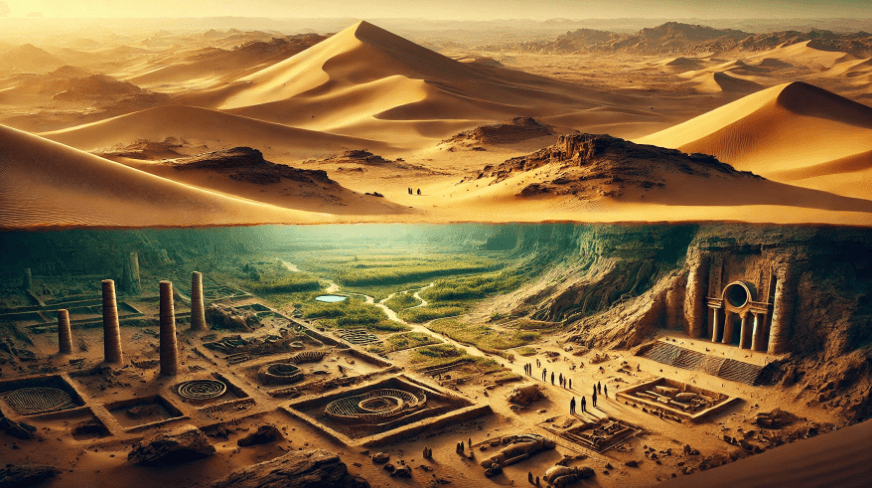
The Hidden City Beneath the Desert
🏜️ The Hidden City Beneath the Desert
The Mystery Beneath the Sand
In the vast emptiness of the Algerian Sahara, far from the reach of modern infrastructure or satellite maps, lies a legend that has haunted archaeologists, mystics, and explorers for over a century. Known in local folklore as Zarvân, the so-called “City of Echoing Stone” is said to rest beneath the dunes—untouched by time, preserved in perfect darkness.
While many dismissed the story as myth, a peculiar series of events in the early 20th century gave it unexpected credibility. In 1927, French archaeologist Dr. Lucienne Dufresne claimed to have discovered a subterranean city beneath the sands—complete with structures, symbols, and materials that could not be placed within any known historical context. Her findings were quickly buried, both literally and politically.
But the whispers remain.
A Forgotten Expedition
🧭 The 1927 Discovery
Dr. Lucienne Dufresne led a French-funded team deep into the Sahara, following clues from an obscure 17th-century Latin journal found in Marrakesh. The document referenced a city that “sings without wind” and glows beneath the desert’s skin—a city designed not for humans, but for beings “who walk without shadow.”
After weeks of travel and two guide abandonments, the team uncovered a black stone staircase descending into the earth. What they found below shocked even the seasoned archaeologists: a massive, perfectly preserved network of obsidian corridors, flowing with faint electromagnetic charge. The walls pulsed in rhythm, and engraved symbols resembled no known language.
According to Dufresne’s private journals, they encountered a central chamber containing a levitating sphere—smooth, metallic, and constantly rotating. Observers claimed it emitted visions: fragments of their own pasts, alternate presents, and apocalyptic futures.
🛑 The Suppression
Within days, two team members went missing. One reappeared—delirious, speaking in unknown syllables. The other was never found. Radio equipment failed. Clocks stopped. Soon after, a sandstorm buried the site entirely. Dufresne was discredited by her peers. Her journals vanished for 60 years, reportedly taken by French colonial authorities.
The Strange Evidence
📜 No Historical Match
What makes Zarvân different from other “lost city” myths is the absence of any historical or cultural match. The architecture described by Dufresne does not align with any Berber, Roman, Phoenician, or even ancient Egyptian traditions. The city’s alignment to constellations long vanished from the sky suggests astronomical knowledge far beyond any known civilization of the region.
🧲 Magnetic Anomalies
Geologists and military cartographers in the 1960s noted unexplained magnetic distortions in the same region, but their findings were never published in peer-reviewed journals. In recently declassified documents, a French intelligence report from 1963 refers cryptically to “Area Z” as a geological hazard zone of unknown origin.
🎭 Local Myths and Warnings
Among Tuareg elders, stories persist of “metal-faced men” and singing stone corridors that consume anyone who enters. They describe Zarvân not as a relic of the past, but as a living city, one that appears only to those it chooses. It is not meant to be found—it reveals itself when it wants something.
Theories Surrounding Zarvân
🧠 1. Pre-Human Civilization
Some fringe theorists suggest that Zarvân may be the work of a pre-human civilization—a species or group that existed before Homo sapiens in deep prehistory, possibly erased by a natural catastrophe or by design. The city’s materials and energy emissions, as described, suggest a level of technology unknown to classical antiquity.
👁 2. Psychological Projection or Mass Hallucination
A more skeptical interpretation posits that Dr. Dufresne and her team may have experienced shared hallucinations brought on by dehydration, stress, or gas leaks. However, the consistency of journal entries, sketches, and symbol records makes this explanation difficult to prove—especially since many symbols reportedly match patterns later discovered on Mesopotamian cylinder seals, despite having no known connection.
📡 3. Temporal Distortion or Interdimensional Rift
One of the most extreme theories suggests Zarvân is not of this world—or at least not of this timeline. The electromagnetic interference, distortion of time perception, and visions seen in the central chamber are interpreted as evidence of temporal instability, a rip in space-time where multiple dimensions momentarily converge.
What We Know for Certain
Despite the lack of official recognition, the legend of Zarvân continues to fascinate historians, adventurers, and conspiracy theorists alike. New satellite images frequently show nothing—just sand. But every few years, desert nomads speak of glowing dunes, of vibrations in the ground felt at midnight, of unmarked planes hovering near ancient rock formations.
And then there are the missing people.
Since 1999, at least seven documented expeditions into the area have vanished without trace—no radio contact, no rescue signals, no bodies.
Unanswered Questions
- What was the true purpose of Zarvân, and who built it?
- Why did French authorities suppress Lucienne Dufresne’s findings?
- Is the city still shifting beneath the sand—or alive in some unknowable way?
- Are the visions seen within the temple hallucinations… or memories from another reality?
The Modern Obsession
“Zarvân is not just an archaeological curiosity. It is a question mark carved into the Earth.”
— Professor Idris Tahiri, 2008
The mystery of Zarvân continues to haunt the edges of official science and history. Whether it is a hoax, a mass delusion, or a glimpse into a forgotten epoch, it challenges our perception of time, memory, and truth. In an age of satellites and AI, the fact that such a place could still remain hidden gives many pause.
And maybe… that’s the point.